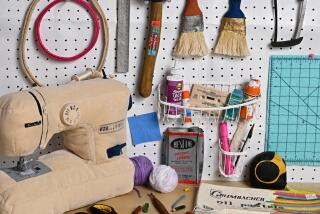He’s Cast in the Artistic Mold
Bill Yancy was worried about King Kameha’s waist, already larger than life.
“Will it fit?” asked Yancy, dressed in his silver-colored lab coat and working out of his foundry in Escondido.
“He’s the George Washington of Hawaii, and we want to get this just right,” said Yancy, who was in the midst of casting the statue of the islands’ monarch, King Kamehameha I.
Yancy’s assistant, son Matt, protected by an apron, nodded, and the two began the dangerous ballet of hoisting a fiery crucible of molten bronze and pouring the 2,500-degree metal into a mold.
Detail is the rule, not the exception, at Yancy’s Hammerman Foundry in Escondido, a workshop dedicated exclusively to casting artworks.
Opening a foundry, especially one that works with artists rather than commercial and industrial clients was a risk, Yancy acknowledged. It was a gamble he took eight years ago after leaving a career as an engineer with the telephone company.
Armed only with what he had gleaned from two semesters of bronze casting at neighboring Palomar Community College, Yancy now casts more than 1,000 pieces a year for artists from as far as Hawaii and Italy.
“We sweat blood, our life’s work, and then we turn it over to Bill,” said Elmo James, a sculptor. It’s a collaboration necessary for all artists who want their work in bronze. Original artworks, which come in almost any medium, from clay and marble to cardboard and feathers, are turned over to Yancy, who has a background as a woodcarver. Most of Yancy’s assistants also are artists.
Molds are made in a painstaking and complex process that involves hot wax, plaster, steam chambers and kilns--all before the liquid bronze is poured.
Yet these technical undertakings are only part of translating the artwork into its new bronze form. “When you work with an artist this closely, it’s not just a physical thing, it’s emotional,” Yancy said.
After consultation with the artists when the molds are complete, the Yancys go into action.
“This is the exciting part--look, just like a little volcano,” said Celou Bonnet, a French artist who works at Hammerman.
The crucible, swung from an overhead joist under the guidance of the Yancys, traveled a path from furnace to mold where it was tipped forward, radiating heat and a fierce light. The molten bronze pours like honey, both apricot and quicksilver in color.
Mariah, a black-and-white hound with a Dalmatian’s affinity for flame, stood by as quietly transfixed as a bird dog before the kill.
When the pour was completed and the piece set aside to cool, with the sense of suspense finally over, Bonnet sighed with relief. “I never get used to this.”
The ingredients in this alchemist’s workshop, brown ingots weighing 25 pounds each, are piled to one side. Maybe one day they’ll make a mistake and deliver gold, Bonnet joked.
Among the junk yard-like jumble of shovels, clamps, sand piles and plaster dust, dolphins arch their silvery backs, mermaids recline and a modernistic-looking stick figure appears to chase up a six-foot-tall ladder after a crescent moon.
There are few perfect casts, Yancy said. The challenges that have bedeviled bronze casters since ancient times are the same today in this classic craft.
“You hope for perfection,” but, Yancy explained, gravity plays a part. Metal shrinks, cracks must be welded, pits filled, slick spots textured, inadvertent roughness smoothed. The trick is to “resist the temptation to do it your way,” said Yancy. “Your responsibility is to the artist, not to yourself. The key is to make the repair, to weld one finger, for instance, and be true to the artist’s original intent.”
There have been some clients, however, who would have it otherwise. One amateur sculptor returned to Hammerman in a huff after unsuccessfully trying to peddle her figurine to several galleries. Did you know this has an ugly face? she demanded of Yancy. He allowed that he had noticed. “Well, why didn’t you fix it?,” the disgruntled woman demanded.
Tempers run high, even with accomplished artists, Yancy said. “This is like having a child. You want everything just right. I understand that.”
“Feathers are the hardest,” he said. Shelf upon shelf of molds rise from floor to ceiling in his work room, piled with owls and ballet dancers, eagle wings, pelican parts and modernistic-looking fragments.
“We go from the itty-bitty to the great big,” Yancy said, holding in his palm a cunningly crafted bronze dragon hatching from an egg. King Kamehameha I, an 18th-Century monarch known in Hawaii as an enlightened ruler, qualifies as big. At 9-feet tall he had to be cast in 11 different parts and carefully welded together.” Now installed at the Grand Hyatt Hotel on Maui, the bronze king is surrounded by mermaids, dolphins and another figure, a torch-bearer with a real torch, Yancy said.
Does he ever feel the pull of Pygmalion, the figure of Greek myth who lost his heart to a statue of his own creation? “I can tell you,” Yancy said, looking at a mermaid. “It happens all the time.”
More to Read
The biggest entertainment stories
Get our big stories about Hollywood, film, television, music, arts, culture and more right in your inbox as soon as they publish.
You may occasionally receive promotional content from the Los Angeles Times.










